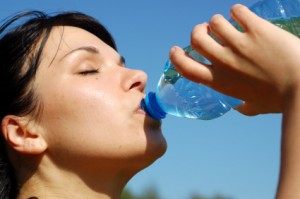 Why is there an article about drinking water on a blog for window cleaning you might ask. Apart from the fact that water is the most common tool we use to perform our work, it is also important to drink often to keep ourselves running optimally throughout the day… or so we thought.
Why is there an article about drinking water on a blog for window cleaning you might ask. Apart from the fact that water is the most common tool we use to perform our work, it is also important to drink often to keep ourselves running optimally throughout the day… or so we thought.
Most of us grew up thinking we needed to drink eight glasses of water each day. We were told this because our parents were told this. It is a myth, and a study by the University of Pennsylvania shows that hydration isn’t as simple as drinking 64 ounces of water each day. So where does the standard advice come from? “Nobody really knows.” says Dr. Stanley Goldfarb at the University of Pennsylvania, There is no clear benefit from drinking increased amounts of water.”
Understanding hydration
The human body is comprised of around 60% water, and is a well-tuned balancing machine. If we need sleep, we sleep. If we need food, we eat. And if we need water well, we drink. Another commonly held myth about hydration is that our thirst mechanism doesn’t kick in until after we are dehydrated and that simply isn’t true. Water in the body is measured in two ways; dehydration, the lack of water circulating in the blood stream, and hydration, the amount of water being held in bodily tissue. Dehydration occurs when the concentration of the blood rises 5% (our thirst mechanism is triggered at 2%) a way to visualize this is a reduction of 2% of body weight (4 lbs for a 200 lb man). With this picture we can start to see that many of us are simply not in a position of risk for dehydration over the course of a regular day.
Also, hydration is not as simple as drinking more water as excess water doesn’t actually increase hydration, it only decreases the blood concentration and throws electrolytes out of balance. Fluid is stored in our fat and muscle tissues, with fat cells holding 15-25% water and fat cells holding up to 72% water. Therefore it is difficult to be properly hydrated if you are overweight. An overweight person might find themselves more often thirsty, causing them to drink more water as their body retains less than an average weight person while depleting nutritional stores and disrupting electrolyte balances.
The best way to self-assess your hydration level is by examining the colour of your urine. It shouldn’t be a dark colour, nor should it be completely clear. The colour of our urine is affected by many things including the foods we eat, vitamins, medications etc. A light yellow colour is the best. If you wake up in the middle of the night to urinate, or go more than 5 times per day you’re drinking too much.
Getting what we need
Rethinking hydration leads us to consider the water levels in our food. For example, an apple is 84% water, and yes the water from coffee, tea or alcoholic beverages do count. There are many ways to hydrate your body with foods that add to your nutrition whereas water depletes our system without adding anything back in. Coconut water, kombucha, herbal teas, coffee and soups are all great ways to hydrate your body, and avoid sugary sports drinks unless you engage in very strenuous and long work-outs.
Work on resetting your water addiction by ditching that monster-size 24 oz glass in favour of a teacup size and decrease body fat to improve your hydration. “There’s no evidence to drink more water than thirst dictates”, Goldfarb says. “If one is just playing a game of indoor tennis or having a short run on an indoor treadmill, the need to maintain hydration during that is just non-existent” Goldfarb advises.
So as the doctor says; go easy on the water. We need it to clean windows!